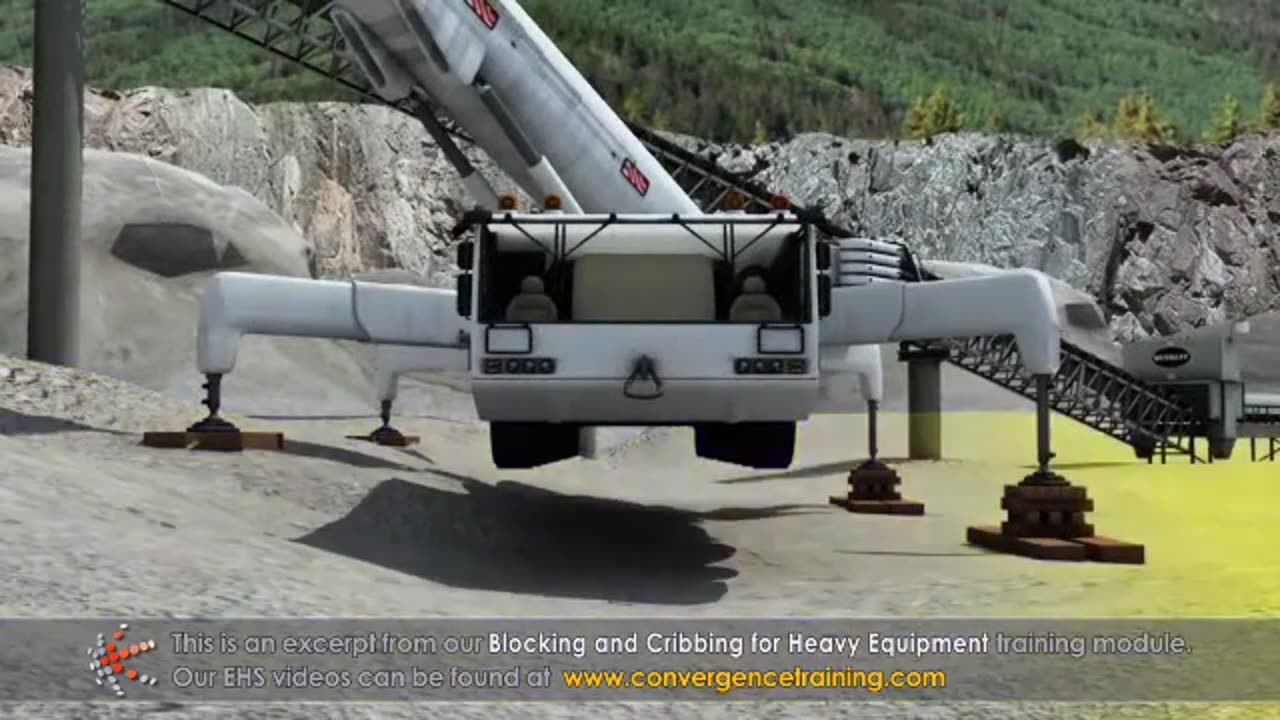Premium Only Content

Blocking and Cribbing Training for Heavy Equipment
**Blocking and Cribbing Training for Heavy Equipment** is essential for workers who are involved in securing and stabilizing heavy machinery during maintenance, repairs, or other activities that require equipment to be temporarily lifted, moved, or tilted. Proper blocking and cribbing techniques prevent accidents by ensuring that heavy equipment remains stable and secure, reducing the risk of shifting or collapsing.
### **1. Overview of Blocking and Cribbing**
- **Blocking**: The act of placing stable materials (like wooden blocks, steel, or other sturdy materials) under or around heavy equipment to secure it in place. This is commonly used when lifting or supporting machinery temporarily.
- **Cribbing**: The technique of stacking blocks or materials in a crosswise fashion (similar to the structure of a crib) to create a stable base for equipment. Cribbing is typically used to support heavy loads or prevent equipment from shifting while in operation or during maintenance.
### **2. Purpose of Blocking and Cribbing**
- **Prevent accidents**: The primary purpose is to prevent equipment from rolling, shifting, or falling during maintenance, transport, or when it's being lifted.
- **Ensure worker safety**: When workers are working beneath or near heavy equipment, blocking and cribbing techniques provide the necessary stability to avoid accidents such as crush injuries.
- **Provide stability**: They are used to ensure that the equipment remains in a stable, secure position, minimizing any movement or shifting that could lead to equipment damage or worker injury.
### **3. Key Components of Blocking and Cribbing Training**
#### **1. Identifying Safe Materials**
- **Wooden Blocks**: Commonly used for blocking, they must be of sufficient strength and thickness. Typically, hardwood like oak is used for its durability and ability to withstand heavy loads.
- **Cribbing Material**: Cribbing often involves using a variety of materials, including wooden blocks, steel cribbing, or specialized plastic cribbing blocks designed for stability and durability.
- **Steel or Metal Supports**: In some situations, metal blocking materials may be used, especially for extremely heavy equipment.
- **Inspection of Materials**: All materials should be regularly inspected for signs of wear, damage, or degradation. Cracked or weakened materials should not be used.
#### **2. Proper Blocking Techniques**
- **Before Lifting**: Blocking should be placed before any lifting equipment (like jacks or cranes) is engaged. This ensures the load remains secure before and after lifting.
- **Positioning**: The blocks should be placed under the most stable parts of the equipment, such as the chassis or axle, while ensuring the weight is evenly distributed to avoid tipping.
- **Stacking**: When stacking blocks, ensure they are stacked in a way that prevents shifting or collapse. Blocks should be stacked in a crisscross pattern, with each layer positioned perpendicular to the layer below it.
- **Load Distribution**: Distribute the weight of the equipment evenly across the blocks. For larger or heavier equipment, more blocks may be necessary to provide support.
- **Height Considerations**: Ensure that the blocking does not create a situation where the equipment is unstable or at risk of toppling. Use the correct number of blocks to raise the equipment safely.
#### **3. Cribbing Techniques**
- **Cribbing Pattern**: Cribbing is typically done by creating a pyramid-like structure with wooden blocks. The blocks are arranged in a series of layers, where each layer is stacked at right angles to the one below it.
- **Layering and Cross-Bracing**: The blocks should be stacked in alternating directions to create a crisscross pattern that provides both vertical and lateral stability.
- **Cross-Bracing for Stability**: Ensure that cribbing blocks are cross-braced, so the structure resists any shifting or movement from the weight of the equipment.
- **Height and Load Limits**: The height of the cribbing should be kept to a safe limit, and the cribbing should be built to support the weight of the load without becoming unstable.
#### **4. Safety Considerations**
- **Ensure Adequate Support**: The primary goal is to ensure that the equipment is fully supported at all times. Blocks should be positioned so that no part of the equipment is left unsupported.
- **Use of Jacks and Lifts**: When lifting equipment to place blocks or cribbing materials, always use hydraulic jacks or lifts rated for the weight of the equipment.
- **Avoid Working Under Unstable Equipment**: Never work under equipment that is not properly blocked and cribbed. Always double-check that the blocks and cribbing are secure before beginning any work.
- **Check for Shifting**: After placing the cribbing and before working, make sure the equipment has not shifted or settled in an unsafe manner.
- **Proper Positioning of Personnel**: Workers should position themselves safely, avoiding placing themselves under the load. If a worker must work near equipment, they should ensure that proper blocking and cribbing have been set up first.
#### **5. Securing the Equipment During Transport**
- **Transport and Movement**: In some cases, equipment needs to be blocked and cribbed during transport (e.g., when using flatbeds or trailers). This requires additional support to ensure that the equipment does not shift during transit.
- **Secure the Load**: When moving heavy equipment, always secure the load with straps or chains to prevent movement while in transit.
#### **6. Training on Tools and Equipment**
- **Lifting Devices**: Training should include proper use of jacks, cranes, or other lifting devices to raise the equipment and place it on blocks or into cribbing.
- **Cribbing and Blocking Kits**: Provide workers with the proper blocking and cribbing kits, including blocks, wedges, and other materials needed to properly secure equipment.
### **4. Best Practices**
- **Use Correct Materials**: Always use materials that are appropriate for the weight and size of the equipment being worked on.
- **Follow Manufacturer Guidelines**: Refer to the manufacturer’s instructions for any equipment-specific blocking and cribbing requirements.
- **Regular Inspections**: Regularly inspect cribbing and blocking materials for damage, wear, or degradation. Replace materials when necessary.
- **Never Overload**: Never exceed the load-bearing capacity of the cribbing or blocking materials.
- **Ensure Stability**: Always test the stability of the cribbing or blocking before starting work. Make adjustments if needed.
### **Conclusion**
Blocking and cribbing are essential skills for anyone working with heavy equipment to ensure safety during lifting, maintenance, or repairs. Proper training in these techniques can help prevent accidents and injuries, ensuring that equipment remains stable and secure at all times.
-
 1:04:52
1:04:52
Geeks + Gamers
2 hours agoDisney RATIO'D on Christmas Day | Mufasa Embarrassed By Sonic 3
13.8K1 -
 LIVE
LIVE
Sm0k3m
6 hours agoPlaying games on Rumble
245 watching -
 10:37
10:37
Russell Brand
2 days agoHow is this even allowed?
113K692 -
 1:37:26
1:37:26
Real Coffee With Scott Adams
3 hours agoEpisode 2701 CWSA 12/26/24
40.2K21 -
 2:58:58
2:58:58
Wendy Bell Radio
7 hours ago9 Steps Ahead
80K105 -
 LIVE
LIVE
LFA TV
16 hours agoTIME FOR A NEW SPEAKER! | LIVE FROM AMERICA 12.26.24 11am EST
5,297 watching -
 1:40:22
1:40:22
Game On!
13 hours ago $4.43 earnedNFL Thursday Night Football Seahawks at Bears EXPERT Picks!
33.3K9 -
 1:50:54
1:50:54
xBuRnTx
3 hours agoWho's Ready for New Years!
23.5K1 -
 12:09
12:09
Tactical Advisor
15 hours agoSmith & Wesson Shield Plus Carry Comp
19.3K1 -
 4:35:25
4:35:25
Father Russell
8 hours agoDelta Force | Not A Woman? | Mad Martigan Time
60.9K5